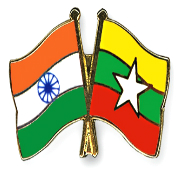Indo-Myanmar Relations
India and Myanmar are immediate neighbours, sharing a long land border of over 1643 kms and a maritime boundary in the Bay of Bengal. Four Indian states – Arunachal Pradesh, Nagaland, Manipur and Mizoram share boundaries with Myanmar. The two countries have close historical, spiritual, linguistic and ethnic ties. Myanmar is the only ASEAN country next to India and a gateway for India’s Act East and Neighbourhood First policies.
Historical Ties
Cultural and trade links between India and Myanmar date back over two millennia. Buddhism was introduced from India which shaped religion, language and culture in Myanmar. Myanmar became part of British India in the 19th century after three Anglo-Burmese wars from 1824-1885. Burmese territories were administered as a province of India by the British Raj. Myanmar’s independence movement had links with Indian nationalist leaders. Subhas Chandra Bose gave his famous “give me blood and I will give you freedom” speech in Myanmar and formed the Indian National Army (INA) with Burmese fighters against British.
After it became independent in 1948, India was among the first nations to establish diplomatic ties after Myanmar. Bilateral relations have remained largely cordial and strong in the early years due to deep cultural connections, and regional cooperation. Myanmar opposed Pakistan in the 1948 Kashmir war. Close bond continued between the democratic governments in early years under Prime Ministers U Nu and Nehru guided by Panchsheel.
India condemned the 1962 military coup in Myanmar suspending democracy. This caused tensions between the two nations. India supported the pro-democracy movement against the military regime in Myanmar in 1988 which soured ties further leading to a drift. Bilateral relations started improving gradually from 1993 as part of India’s Look East policy in the post Cold war scenario.
Present Times
In February 2021, the military took over power in Myanmar, forming the State Administrative Council. The country continues to undergo political turmoil since then. Despite that, India sees Myanmar as a key partner for regional connectivity and cooperation under its Act East and Neighbourhood first policies as well as strategic foil to China’s expansive influence in the region.
Bilateral Mechanisms
Several institutional dialogues foster regular consultations between India and Myanmar. These include:
- Foreign Office Consultations led by the Foreign Secretaries
- National Level Meeting on security cooperation and border issues
- Sectoral Level Meetings on specific areas
- Regional Border Committees of armed forces officials
- Joint Boundary Working Group on boundary matters
High Level Visits
There is a tradition of regular high-level visits between the two countries. Prime Minister Modi, External Affairs Ministers and National Security Advisors have visited Myanmar. Myanmar’s leaders like State Counsellor Aung San Suu Kyi had also undertaken visits to India. During these visits, agreements across sectors like trade, culture and security have been signed.
Development Cooperation
India has an active development assistance programme for Myanmar valued at over $1.75 billion in grants. Key projects by India include:
- Kaladan Multimodal Transit Transport project
- Trilateral Highway connecting Northeast India with Myanmar and Thailand
- Building educational institutions like Myanmar Institute of Information Technology
- Rakhine State Development Programme
- Restoration of heritage monuments like Ananda Temple
A $500 million Line of Credit funds additional connectivity and infrastructure projects in Myanmar. In 2022, the two countries had also signed an agreement to build an Integrated Check Post at the Tamu border.
Capacity Building
India offers technical and economic cooperation to Myanmar via the Indian Technical and Economic Cooperation (ITEC), scholarships and specialized training programmes. Over 250 Burmese participants attended digital ITEC courses in 2021-22. Myanmar students also receive higher education scholarships in India.
Defence Relations
Defence ties are a key pillar of India-Myanmar relations, focused on training, naval ships, equipment supplies and cooperation on security issues. The army chiefs and defence secretaries of both countries have exchanged visits in recent years. India and Myanmar have also cooperated on border security operations against insurgent groups. The two countries also participate in India-Myanmar Bilateral Army Exercise (IMBAX) from time to time.
Commercial Ties
Myanmar is an important partner for India’s connectivity with Southeast Asia. Bilateral trade has grown from $328 million in 1997-98 to over $1 billion in 2021-22, conducted under the India-ASEAN trade pact. India is Myanmar’s 5th largest trade partner now. Efforts are ongoing to enhance private investment and energy cooperation between the countries.
Health, Science & Technology
Joint Working Groups foster cooperation in health, science & technology domains. India has provided medicines, COVID vaccines and medical gear to Myanmar during the pandemic. The countries also work together in areas like renewable energy, oil & gas through specific committees.
Connectivity
Direct flights connect Indian cities to Yangon in Myanmar presently. Efforts are ongoing to improve connectivity via air and land routes between Myanmar and India’s northeast. Integrated border checkpoints at Tamu-Moreh and Rih-Zowkhawthar are also operational now.
Disaster Relief
India has provided prompt relief and assistance during natural disasters in Myanmar, including after cyclones, earthquakes and pandemics. This includes supplies of medicines, vaccines and even deploying aircraft and helicopters during Cyclone Nargis in 2008.
Culture
The two countries share deep cultural linkages rooted in Buddhism, architecture and language. India is helping to restore pagodas and temples of significance in Myanmar through archaeological efforts. There are also regular cultural exchanges between artistes and students. The Indian Embassy actively promotes cultural connections.
Indian Community
A small but active Indian-origin community lives in Myanmar today, largely concentrated in Yangon and Mandalay. Many trace their roots to colonial-era migrants. They mainly operate businesses like shops, restaurants, import-export trade, pharmaceuticals, education and software services.


